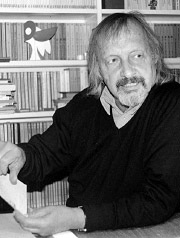Celestino Piatti was the third of five sons born to a Ticinese stonemason and builder and his wife Anna in Dietlikon, near Zurich. After attending secondary school and general classes at the School of Applied Arts in Zurich, he completed an apprenticeship as a graphic designer in the print shop of Gebrüder Fretz AG between 1938 and 1942. Following a couple of years of active military service, he started his first job at Fritz Bühler’s renowned Basel studio in 1944, where he worked until 1947, eventually becoming the studio director.
In 1948 he set up his own commercial art studio in Riehen, where his now legendary career as a poster designer began with his award-winning debut work, a series of Basel trading stamps. The first Deutscher Taschenbuch Verlag (DTV) paperback bearing Piatti’s illustrations was published in 1961, its instantly recognisable white background a stylistic feature. Piatti subsequently applied it to more than 6,000 book titles over the next 30 years, and it developed into an unmistakeable brand image for the publisher. In 1966, Piatti moved his home and business to Basel and then to Duggingen in 1973, where he lived and worked with his second wife Ursula and their family until his death. As well as the huge amount of work he did for DTV, Piatti designed more than 500 posters. Many of these are now regarded as iconic works of art both in Switzerland and abroad, with a few posters kept in the Museum of Modern Art in New York. His striking artwork also includes several series of Swiss stamps. In 1957, Piatti became a member of the Alliance Graphique Internationale (AGI).
Piatti was also a passionate illustrator and, from 1963, he channelled his love of the animal kingdom into much-loved children’s books, the most successful of which have even been published in Chinese and Japanese. Generations of children around the world have learned to read through his illustrated schoolbooks. He was also a long-standing contributor to the Nebelspalter magazine, producing title pages for the publication on the themes of politics and social criticism. From 1962, Piatti regularly sought refuge in his Parisian studio. The works he created there as an independent artist, along with those he produced in Basel and Duggingen, form an unforgettable part of his impressive oeuvre.


